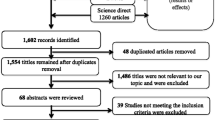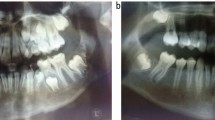Abstract
Aim
In the UK, first permanent molars (FPMs) of poor prognosis are often planned for extraction so that second permanent molars (SPMs) erupt favourably to replace the FPMs. However, there is little published data to support this treatment strategy. The aim of this study was to assess the success of planned FPM extractions conducted 5 years ago at a dental hospital in London.
Methods
Two hundred and thirty-six SPMs from 63 patients were clinically assessed. The position of each SPM was recorded in relation to the second premolar, against patient Angle’s classification and SPM radiographic development stage at the time of FPM extraction.
Statistics
Results were analysed using ordered logistic regression.
Results
At the time of FPM extraction, only 54 % of SPMs were at the “ideal” stage of development (Demirjian’s dental development stage E). Upper and lower arches yielded significantly different results with 92 % of all upper extractions resulting in complete space closure regardless of SPM development stage. Only 66 % of lower FPMs extracted at SPM stage E had complete space closure and no significant relationship was found between lower SPM development stage and its subsequent space closure. Space closure in both arches also appeared independent of patient Angle’s classification.
Conclusions
Although only over half the patients had FPMs extracted at the “ideal time”, this did not appear to influence successful positioning of the upper or lower SPM. More research is required to investigate and confirm which predictive parameters have a significant effect on post-extraction orthodontic development, especially in the lower arch.






Similar content being viewed by others
References
Cobourne M, Williams A, McMullen RA. Guideline for first permanent molar extraction in children. 2004 (updated 2009) http://www.rcseng.ac.uk/fds/publications-clinical-guidelines/clinical_guidelines/index.html. Last accessed Dec 2011.
Demirjian A. A new system of dental age assessment. Hum Biol. 1973;45:211–27.
Gill DS, Lee RT, Tredwin CJ. Treatment planning for the loss of first permanent molars. Dent Update. 2001;28:304–8.
Jalevik B, Moller M. Evaluation of spontaneous space closure and development of permanent dentition after extraction of hypomineralized permanent first molars. Int J Paediatr Dent. 2007;17:328–35.
Koch G, Hallonsten AL, Ludvigsson N, et al. Epidemiologic study of idiopathic enamel hypomineralization in permanent teeth of Swedish children. Community Dent Oral Epidemiol. 1987;15:279–85.
Leppaniemi A, Lukinmaa PL, Alaluusua S. Non-fluoride hypomineralizations in the permanent first molars and their impact on the treatment need. Caries Res. 2001;35:36–40.
Ong DC-V, Bleakley JE. Compromised first permanent molars: an orthodontic perspective. Aust Dent J. 2010;55:2–14.
Skeie MS, Raadal M, Strand GV. The relationship between caries in the primary dentition at 5 years of age and permanent dentition at 10 years of age—a longitudinal study. Int J Paediatr Dent. 2006;16:152–60.
Thilander B, Skagius S, Orthodontic sequelae of extraction of permanent first molars. A longitudinal study. Rep Congr Eur Orthod Soc. 1970;429–442.
Acknowledgments
We would like to thank Hilary Jones and Frances McGeown for their help in obtaining the necessary patient records, but above all Dr Donald Derrick for his contribution to the statistical analysis.
Author information
Authors and Affiliations
Corresponding author
Rights and permissions
About this article
Cite this article
Teo, T.K.Y., Ashley, P.F., Parekh, S. et al. The evaluation of spontaneous space closure after the extraction of first permanent molars. Eur Arch Paediatr Dent 14, 207–212 (2013). https://doi.org/10.1007/s40368-013-0042-7
Received:
Accepted:
Published:
Issue Date:
DOI: https://doi.org/10.1007/s40368-013-0042-7




